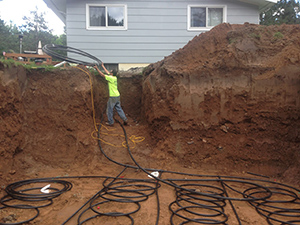Planner’s Portfolio: Renewable Energy

The 5th issue in the Planner’s Portfolio series focuses on renewable energy systems and their regulatory issues.
In an age of wildly fluctuating energy costs and growing environmental consciousness, many property owners are opting to install small-scale renewable energy systems to offset the amount of energy they need to draw from the electric grid. In the past, these systems were too costly to be widespread, but advances in technology as well as government incentives and private investment have caused the system costs to decrease dramatically in recent years. Owing to the relative rarity of renewable energy installations previously, most municipalities have not included language in their ordinances to regulate the location, size, or approval procedure for these systems. While it is uncommon for municipalities to out-and-out prohibit renewable installations in their boundaries, not addressing renewable energy at all can still hinder the process. Approving zoning variances and special permits for renewables can cost both the municipality and the applicants time and money, which can serve to discourage the adoption of renewable energy systems.
 Renewable Energy systems have different issues in the County’s various Character Areas. Growing Suburbs are frequently ideal for renewable energy systems. Large open areas can accommodate geothermal wells, ground-mounted solar, or even small wind systems. These areas can enhance their natural benefits by creating a favorable regulatory environment by establishing sensible, permissive regulations for renewables and streamlined permitting processes to encourage the renewable market.
Renewable Energy systems have different issues in the County’s various Character Areas. Growing Suburbs are frequently ideal for renewable energy systems. Large open areas can accommodate geothermal wells, ground-mounted solar, or even small wind systems. These areas can enhance their natural benefits by creating a favorable regulatory environment by establishing sensible, permissive regulations for renewables and streamlined permitting processes to encourage the renewable market.
Mature Neighborhoods can pose a challenge to the installation of renewables owing to the density of the building stock. Geothermal systems must usually be dug vertically, and there could be difficulty getting large boring equipment onto a small site. Similarly, it would be difficult to erect free-standing wind structures to the necessary height to avoid obstructions and access the strongest winds. Mature tree coverage can reduce the effectiveness of rooftop solar, and smaller, older buildings might not have enough roof area or appropriate underlying structures to support an adequately sized system. Still, there are a number of opportunities to be found in Mature Neighborhoods as well. Smaller buildings, particularly those built with a party wall such as twins, row homes, and connected blocks of retail, tend to be more energy efficient to begin with, meaning that a smaller renewable system would still have a significant impact on overall energy use. Additionally, a lot of the more urban development features flat roofs, which are ideal for solar installations.
This portfolio aims to provide municipal officials with an overview of renewable energy technology and terminology, as well as the most practical way to regulate it while still providing a renewable-friendly market. For more information, check out the Renewable Energy issue or the entire Planner’s Portfolio series.
